
13-17 February 2017. Even arriving in Cuba is different. We wait for an hour in the baggage collection area for our bags to arrive. While we are waiting the conveyor belt spits out dozens, maybe hundreds, of huge plastic-wrapped balls that roll across the floor and gather in a pile. They are maybe two or three feet in diameter and whatever is in them is shrouded in layers and layers of plastic. There appears to be no tags on them, and we conclude they must be part of the mysterious way Cubans manage to import goods into their country.
Our Cuban friend, “Pedro”, tells us that it is forbidden to import cars, but they can import car parts, so entire cars are imported in pieces. They are forbidden to import electric bikes but can import them in pieces from Panama. This seems as good an illustration as any of the bizarre and confounding reality of Cuba today.
After claiming our bags we line up for another hour to buy Cuban tourist currency, CUC’s, and then finally get a taxi to our casa particular in Old Havana. The apartment is up four long flights of stairs in what seems to be a gritty and run-down part of town, until we realise that except for the restored areas it’s all gritty and run-down.
Luckily there are some other people entering the building at the same time and two strong young men carry our bags up for us. In the casa we have an en suite room off the communal dining room where we are served breakfast every morning. Gerardo is our host. His son Erik cooks breakfast. Getting up early to first buy the food, and then cook breakfast for guests at his father’s casa is a second job. As with just about everyone in Cuba, one job is not enough to support even a small family. Breakfast is delicious and sumptuous. Every day we are served a big plate of fruit (banana, guava, papaya, pineapple, mamay) and home-made plain yogurt, followed by eggs any style and big hot crispy rolls and butter, coffee and tea and juice, all for 5 CUC (US$5) each.
At the front of the apartment there is a sitting room, and a window onto the street.
From Don: We walked to the nearby Plaza Viejo, which was buzzing with life and music and many restaurants. The buildings that form the perimeter of the plaza have all been beautifully restored, in sharp contrast to the crumbling apartment buildings beyond the perimeter. We had dinner at one of the restaurants just off the plaza: I had the toughest fish I’ve ever had the misfortune to try to eat: it reminded me of Charlie Chaplin in “The Gold Rush” savoring the sole of his boot. I gave up on the fish after a few mouthfuls as my jaw ached, but my feet continued tapping to the fabulous live music.

Havana dates back to the 16th century. Its strategic location allowed the Spanish a base and safe harbour for their conquest of South America, as well as a place for their treasure-laden galleons to refuel and refit before returning to Spain. It has a long history, surviving pirates, wars, occupation, and revolution. In the early 1800’s when many of the mansions were built, it flourished and became so fashionable it was known as the Paris of the Antilles. Havana still lives and breathes this history, the good and the bad, creating a rich visual and energetic jumble.
The city is insistent in a way that’s hard to describe. The crowded streets, the noise, the dirt, the music, the dancing, the feeling of decay and neglect all contribute to the tapestry. There are beautifully restored buildings from several different eras,





and there are endless crowded streets crumbling from fifty years of crushing neglect, especially since the collapse of the Soviet Union in 1991.



There are leafy green boulevards, parks, and suburbs,


and buildings in such a state of disrepair that outer walls have fallen down with fatal results.

There are pockets of beauty

in the same neighbourhood as disintegrating buildings succumbing to the forces of nature with trees and vines growing from the roof and walls.

There is a ruthless poverty that forces the people to be inventive and at times dully resigned, and yet the city somehow survives and thrives with an in-your-face bravado that pulses and pushes at you wherever you go. It’s rarely glamorous (though signs of earlier glamour are everywhere) but it cannot be ignored.
More than in any other city we’ve been to, people live in the many times subdivided mansions of the once wealthy. In Old Havana 85,000 people are squished into a 4.4 square kilometre area. Through open doors to inner courtyards, and from upper balconies, we get a glimpse into the many accommodations created from what were once grand villas.


With the strong support of Fidel Castro, and with the help of overseas funding, the Office of the Historian of the City under the leadership of Eusebio Leal Spengler, has been putting enormous effort into preserving and restoring Old Havana, the core of the original city, and since 1982 a UNESCO World Heritage site. It’s a slow painstaking process one building at a time that is always hampered by lack of funds. Now that Fidel is gone we wonder what will happen. We ask Pedro how Fidel’s brother Raúl, the current President of Cuba, feels about the restoration project. Pedro’s answer is perhaps a little cryptic. He says simply that Raúl is more interested in the economy.
Currently under restoration is El Capitolio Nacional, built in 1929, long before the revolution, to accommodate the Senate and the House of Representatives. Its dome still dominating the Havana skyline, El Capitolio was inspired by the Capitol building in Washington.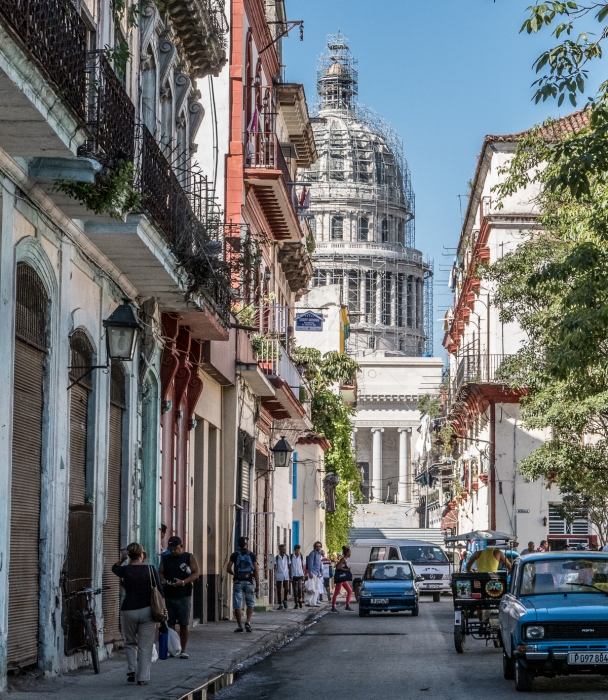
There is a grace that persists no matter the lack of funds for maintenance or restoration. Entire buildings on almost every street
and largely disregarded treasures around every corner
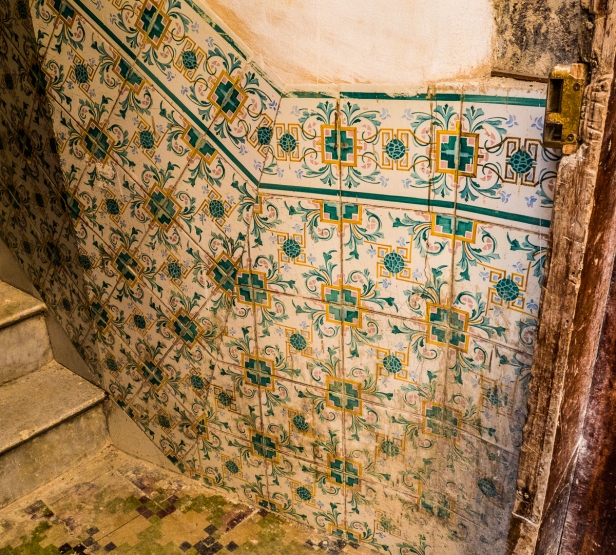
speak of earlier times when beauty was affordable. Despite difficult circumstances the defiant beauty refuses to die.
On another day we explore the church of Our Lady of Mercy (Iglesia de Nuestra Señora de la Merced) and find again the defiant beauty. The paint may be peeling and faded, but age and poverty cannot erase the soaring elegance of design and the rich golden details.
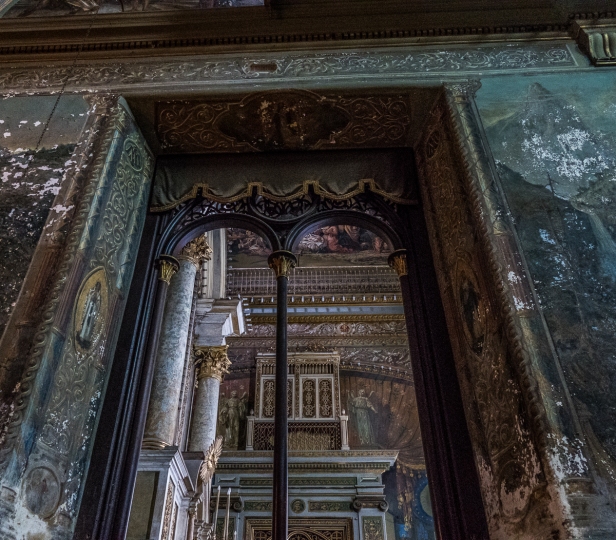
We walk with Pedro down the broad Paseo de Marti, busy with locals and tourists alike,
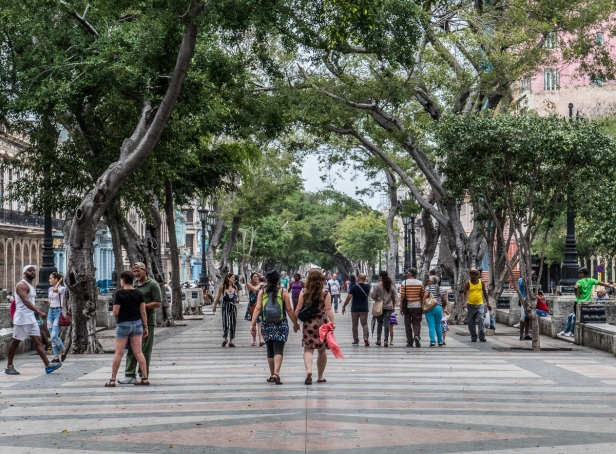
passing school girls dancing,
and a wedding party.

At the end of the Paseo we reach the Malecón, a waterfront boulevard that runs along the north coast of the city, where locals gather to chat, walk, fish, and watch the sunset.
Havana is this:
and this:
and this: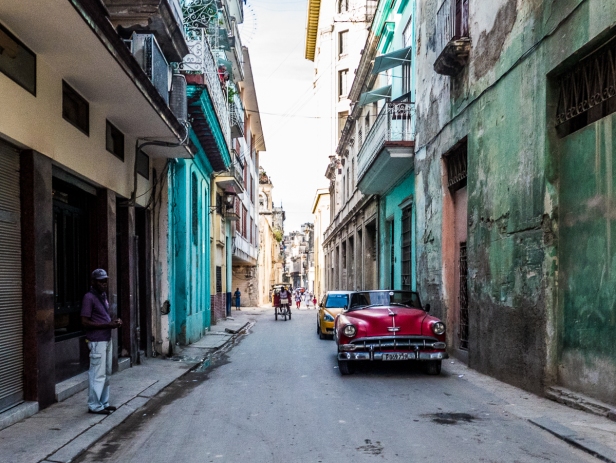
and so much more.
Once the grand dame of the Caribbean with hundreds of magnificent buildings spanning several eras, it is now crumbling and dilapidated except for a slow painstaking rehabilitation that is, one by one, bringing some of these glorious old buildings to life again. The city has an unmistakable charm despite the grittiness of everyday life. It’s a worn old lady with an irrepressible heart and the soul of a musician. Cubans are famous for finding a way to deal with the restrictions they face, and their ebullient spirit cannot be suppressed.
Next post: the people, the cars, the food, the music!
All words and images by Alison Louise Armstrong unless otherwise noted
© Alison Louise Armstrong and Adventures in Wonderland – a pilgrimage of the heart, 2010-2017.

Magnificent photos!
LikeLiked by 1 person
Thanks so much Frank. Appreciate it.
Alison
LikeLike
I could have been right back there with you as I read this and viewed the photos. Your intro at the airport was similar to ours (bizarreness and slowness!), as was your arrival at your casa. We were sure we were in a “bad” neighborhood until we realized every neighborhood looked like that and that none of them was particularly bad at all. You capture well the pride here; Cuba and its denizens are hardy, inventive, resilient souls on the inside; the bedraggled look cloaks a former splendor that cannot stay totally hidden! How long did you spend in Havana itself? (And did you ever get to La Guarida?)
LikeLiked by 1 person
Thanks Lexie. Havana is so full of contrasts, but alas most of it is run down 😦
The building that is missing a wall is still inhabited! We were there for 4.5 days at the beginning then back for another 1.5 days at the end. And yes we got to La Guarida! Amazing place. Will do a post on it eventually.
Alison
LikeLiked by 1 person
It is sad to realize that most of those lovely old buildings would have been razed here in the US. I hope that they will be able to restore many more of them. But then the rents will go up… A vicious cycle.
LikeLiked by 1 person
I’m pleased that there is at least some restoration happening, even if it is at a very slow pace. I’m not sure how rents work in Cuba – since it’s a socialist state they won’t necessarily go up. I don’t know for sure. I do know that the current president is trying to get the economy moving, at least that’s what our Cuban friend told us, so who knows what that will mean.
Alison
LikeLike
A clear and honest report on Havana. A place I have yet to visit but have heard various reports. Your photos compliment your narrative and vice versa. I love those old buildings, full of charm and elegance. What stories they could tell.
LikeLiked by 1 person
Thanks so much Darlene. Havana’s a very unique place, both the buildings, and the energy. We’ve not been anywhere else like it. I too love the old buildings and I’m glad there is at least some restoration happening. Oh the stories! If only walls could speak! That would be an excellent base for a historical novel – take one building and tell the story of it’s construction and of all the inhabitants and their stories throughout the centuries.
Alison
LikeLike
PS forgot to say – James Michener could spin that into a 1000 page novel!
LikeLike
Yes, he could. But I do like the concept. My creative wheels are turning!!
LikeLiked by 1 person
Oh good! *You* will be the one to write it! Even better!
LikeLike
Wow! Brilliant blog! I’d love to hit Havana. Thanks for all the info.
LikeLiked by 1 person
Thank you so much Lee. Hope you get to Havana one day – it really is amazing.
Alison
LikeLiked by 1 person
Your welcome. & yeah dont worry I will:) it looks amazing.
LikeLiked by 1 person
Thank you for this most interesting ‘travelogue.’ It is fortunate that you are Canadians, as (from what I understand) the Trump administration has made it almost impossible for Americans to visit Cuba.
LikeLiked by 1 person
You’re most welcome. I’m glad you enjoyed it mistermuse. As for US citizens visiting Cuba – my understanding is that Obama made it easier for them to visit, and I have friends from the US who have visited within the past year. I am not aware of Trump reversing the situation though I am no expert on this matter. Yes I am very fortunate to be Canadian 🙂
Alison
LikeLike
I just read up a bit – so Trump is taking a hard line against Cuba. I don’t usually follow the news so I didn’t know.
A.
LikeLike
Love your descriptions!
LikeLiked by 1 person
Thanks so much Kay.
Alison xox
LikeLike
Gorgeous photos and fascinating text. My daughter met up with all here study abroad friends from Queretero and is in Cuba now!
LikeLike
Thank you so much Cindy. Havana is really something else. I can’t say we loved it, but there’s no denying it’s power to grab you. I bet your daughter is having an amazing time.
Alison
LikeLike
Wonderful photos. Especially like the one of the bride and groom. So spontaneous.
LikeLike
Thanks Peggy. The bride and groom were just hanging out. There was no one else with them except the young bridesmaid and the man (groomsman, her father?) she was talking to. They were all completely relaxed and totally unaware of me.
Alison
LikeLike
Oh how I love this post Alison!!! I fell deep into Havana’s charm with its once ornate buildings falling apart and it’s history within its layers of peeling paint. Your description of this contradictory city is top notch. I love how you call her a graceful old lady. Can’t wait to read more posts!
LikeLike
Thanks so much Nicole. Havana’s an extraordinary city. As I said to Cindy, we didn’t love it, but it sure can charm the pants of you anyway! She is a graceful old lady if a bit crotchety at times 🙂
Lots more posts coming.
Alison
LikeLiked by 1 person
Can’t wait to read more Alison!
LikeLiked by 1 person
Enjoyed this post a lot, Cuba is so very much on my wish list of places to go! It’s going to be interesting how it all shakes out with Raúl Castro and the new US administration.
LikeLike
Thanks Amanda. I hope you get there. Go! It’s a truly unique place. Not always easy but definitely fascinating. The new US administration doesn’t seem very friendly towards Cuba 😦
Alison
LikeLike
We loved Cuba so much on our first visit that we returned the following year again for more! You have captured the grandeur and the deterioration of the buildings really well with your fab photos. Thanks for bringing it all back to me.
Interestingly, for us, Havana was our least favorite city in Cuba… I’ll wait to see your next posts 🙂
Peta
LikeLiked by 1 person
Thanks so much Peta. We didn’t fall in love with Havana, but it certainly was fascinating, and the people generally friendly and welcoming. And I do think it’s one of the world’s great cities, if only for the history still oozing from those crumbling mansions, and for the undaunted spirit of the people. We quite liked Trinidad, but our favourite places were when we got out of the cities – Viñales, Cay Iguana, and a national park near Trinidad.
Alison
LikeLike
As your magical photos come before my eyes I think I have never seen Havana like this. I’ve seen the cars, the door frames, the people but never the big picture. Showing the streets and views really has left me feeling like have walked in Havana. In 1995 we went to Cuba but did not get to Havana. What a shame.
LikeLiked by 1 person
Thanks so much Sue for your lovely compliment. There will be a lot of the cars and the people in the next post, but I wanted to show an overview first. The city is so much about the architecture and the state of the buildings – it’s the backdrop for everything else. Maybe you’ll get there one day.
Alison
LikeLiked by 1 person
Alison, how do you get such great photos? The one of the bride and groom is straight out of Madison Avenue. You really should submit a portfolio to publishers. Your work deserves to be preserved for the future in print. Seriously!
Libbie
LikeLiked by 1 person
Thank you so much Libbie! What a lovely thing to say. I’m just kind of starting to do something with my photographs now we’re not travelling so much. Many have suggested a coffee table book – maybe one day that will happen. For sure I plan on getting several printed to hang on our apartment walls 🙂
At this point I’m not sure what else I’ll do. I am just learning how to get photographs print ready (as opposed to online) so that’s a start.
Alison
LikeLike
I love these kind of places. Shadows of their former selves, but somehow still magnificent. And I love the bride and groom photo.
LikeLiked by 1 person
Thanks Tracey. The bride and groom had no idea I was taking their photo – always the best kinds of shots. I love your description – shadows of their former selves but somehow still magnificent – it says it perfectly.
Alison
LikeLiked by 1 person
Your photos, along with your narrative, have made Cuba come alive for me, Alison. “Gritty and run down” along with “decay” and “neglect” have summed up Cuba in a way that makes her seem like a beautiful fading old lady with fire in her eyes. As US citizens, we’ve waited a long time to visit the country legally without signing on for a costly tour group and one of the legal visas, but one of these days we’ll get there. You have me dreaming of the country again! Anita
LikeLiked by 1 person
Thank you so much Anita. “a beautiful fading old lady with fire in her eyes” – I love that!
Unfortunately the current US administration is making things difficult again 😦
Alison
LikeLike
What a spectacular opening photo, Alison! Your photos yet again showcase the beauty of places at the other side of the world from where I currently live. As for Cuba, I don’t think I’ll ever get bored of looking at people’s photos from Havana while wishing that somehow I’ll get the chance to go there. I do hope Cuba’s increasingly positive image among travelers will benefit its people.
LikeLiked by 1 person
Thanks so much Bama. Cuba’s a truly fascinating destination. I hope you get there one day. Certainly anyone who works in the tourist industry is benefitting and since these are pretty much the only people making more than barely enough to scrape by, everyone wants to somehow work in the tourist industry. But still, the wealth must spread into the economy somewhat so everyone benefits.
Alison
LikeLiked by 1 person
Reblogged this on World4Justice : NOW! Lobby Forum..
LikeLiked by 1 person
Thanks for the reblog!
Alison
LikeLike
The photo just above the caption “Leafy green boulevards, parks…” with the apartment buildings in the foreground and water in the background strongly reminds me of a Picasso painting. Well done!
LikeLiked by 1 person
Thanks Pam. I’d never thought of it that way before. Must run off and take another look at some Picasso’s 🙂
Alison
LikeLike
Disorder layered on order. Maybe I’m thinking Cubist?
LikeLiked by 1 person
There are two cubist Picasso’s that are brownish in colour that the photo is a little reminiscent of.
LikeLike
I’m very jealous. I live in S. Florida and have been thinking about going to Cuba for years. I may have to start planing a trip there next year. Thanks for the post and the inspiration.
LikeLiked by 1 person
You’re welcome! I hope you get there, it’s an amazing place, and you’re so close! But do take note of CompassAndCamera’s comment below re flying from Canada or Mexico. We flew from Cancun.
Alison
LikeLike
I would love to visit Cuba, even more now reading this beautiful post. I hope to learn more about photography when retire. I have enrolled on a beginners class…lots to learn 😄
LikeLiked by 1 person
Thanks Gilda, I’m glad you enjoyed it. And I hope you get to Cuba. It’s a really unique destination. I have two sisters who are/have been professional photographers who taught me everything I know. Lucky! And there is *still* lots to learn.
Alison
LikeLike
Your photos do a great job of capturing the age, neglect and beauty. This was a splendid read.
LikeLiked by 1 person
Thank you so much! I’m glad you enjoyed it.
Alison.
LikeLike
Your pictures capture the beauty that once was, Alison, and serve as a reminder of why the Cubans in Miami are still so bitter over all of the wealth and lifestyle they were forced to leave behind. The idea of revolution wasn’t a bad one in the beginning, and had the people in Cuba benefited from the change, might have gone well. But politics, both local and international, doomed the country to decades of suffering. Hopefully, with things opening up, the future will be brighter. –Curt
LikeLike
Thanks Curt. Yes, I imagine the Miami Cubans are not happy about the way things evolved, especially since the revolution didn’t go well, though I do wonder if maybe it was better for the general population before the collapse of the Soviet Union. It’s pretty dire at the moment. Unfortunately the current US administration seems to want to undo what Obama achieved re opening the country to US tourists.
Alison
LikeLike
“Unfortunately the current US administration seems to want to undo what Obama achieved re opening the country to US tourists.” I know, and I am irritated. It’s dumb, one of so many dumb things. But I didn’t want to rant again. –Curt
LikeLiked by 1 person
Love, love, love this post and your eloquent thoughts about it. And of course your amazing photography! It brings Havana alive from a fresh perspective. Do you mind if I add? For any American travelers reading these comments and wishing they could go… just fly from Canada or Mexico and you’ll have no problem entering without an official visa or a tour group. I can personally attest to this. Thanks, Alison, for this exquisite look at a truly unique city.
LikeLiked by 1 person
Thank you so much Kelly! I must admit it was a difficult post to put together – so many thoughts, so many photos, so much “inside” information from Pedro. It was a lot to sort through and figure out how to cover it all – so people and cars in the next post 🙂
And thank you for your additional information about how US citizens can get into Cuba. It must be pretty simple to fly to Cancun which is then just a very short flight to Havana.
Alison
LikeLiked by 1 person
We flew in from Panama!
LikeLiked by 2 people
I have not been to Cuba, but Allison, you have described it so beautifully, as I envision it. Your stunning photos are just icing on the cake. I love Don’s comments about the fish, and glad to hear that the music is awesome. Cheers, Caroline
LikeLiked by 1 person
Thanks so much Caroline. Havana’s an amazing place, unlike anywhere else. It really is one of the world’s great cities despite the crumbling neglect. Except for the food. That fish was really something else. We’ve never encountered anything like it. But yes, the music is awesome.
Alison
LikeLike
Such a fabulous tribute to Havana. I want to take the places at their face value, – which is beautiful, no? – but the pictures make me wonder what everything looked like 50-70 years ago. All the best – Susan
LikeLiked by 1 person
Thank so much Susan. You can still see the beauty of long ago, but yes, I too would love to have seen it before the revolution, when it was the belle of the Caribbean. It must have been just gorgeous.
Alison
LikeLiked by 1 person
It gets under everyone’s skin, doesn’t it? 🙂 Easy to see why! Gorgeous photos from you.
LikeLiked by 1 person
Thanks Jo. And yes, it gets under your skin. There’s something about it that grabs you, and sometimes not in a good way, but you’re enthralled no matter what.
Alison
LikeLiked by 1 person
Hi After seeing your photographs it makes me wonder why the politicians keep mucking around with sanctions and travel rules with Cuba . I keep reading but still I don’t understand. I know someone who traveled in Cuba -and loved it.
LikeLiked by 1 person
I don’t understand either. It seems more about power plays than anything to do with Cuba itself. We loved it too. And at times hated it. It’s an intriguing destination. Of course tourists from many places (Canada, Europe, etc) have been going to Cuba for years.
Alison
LikeLike
So close yet soo far away. I just hope the island isn’t gentrified so that the islanders find themselves being outpriced off their own island.
LikeLiked by 1 person
I doubt there’s much of that happening. It’s a very poor country.
LikeLike
Gorgeous beautiful photos and such an interesting post! Thanks for sharing your Havana experience with us. I hope to make it there one day. Your photos of the old woman on the balcony and the bride and groom are stand outs, but they are truly all exceptional!
LikeLiked by 1 person
Thank you so much Ilona. Havana’s an amazing city. I hope you get there one day.
Alison
LikeLiked by 1 person
Quite romantic.
LikeLike
Oh yes, there’s definitely a certain romance about this city. And there’s ordinary gruelling every day life too. Somehow they make it work.
Alison
LikeLiked by 1 person
I can see why it was called the Paris of the Antilles. Lots of similar building styles, even underneath the neglect. Parts of Paris feel that way too, though probably not to the extent of Havana. Very excited to read more about Cuba!
LikeLiked by 1 person
Oh yes, the sense of what once was a grand city is still very evident. I’d love to have seen it in its heyday. Lots more to come about Cuba.
Alison
LikeLike
Just fabulous! You are both such gifted story tellers. I can feel the spirit and the sadness in every word and stunning image. Makes me want to hop on a plane right now.
Chuckling at the airport story. The authorities should know by now that prohibition only makes people more inventive. ‘Jugaad’ we call that inventive workaround in India.
Look forward to the people images.
LikeLiked by 1 person
Thanks Madhu. Oh yes, there is a sadness that permeates the place – all those beautiful buildings falling apart, and the people struggling to have a half decent life – mixed with their resilient spirit and soul-saving music. Hope you get there one day. It’s like nowhere else.
I have more stories to come about the extraordinary inventiveness of the Cubans to get around the restrictions placed on them. And many people images.
Alison
LikeLike
Well done. There is hope for the city and the writer captures it. The spirit of the Cuban has been suppressed but not quashed. Your words enliven it. Thank you.
LikeLiked by 1 person
Thanks so much Oscar. There is hope for Havana, and for Cuba. Bit by bit things are changing.
Alison
LikeLike
It must have been such a stunning city in its day… The rustic parts may have their charm, but I really hope they restore the buildings to their former glory.
LikeLiked by 1 person
I’d love to have seen it before the revolution, when all those buildings were well maintained. As you say it must have been stunning. I’m not that hopeful for restoration at any faster pace than it’s going now, and really the country needs so much more than restored buildings unfortunately.
Alison
LikeLiked by 1 person
So timely. We are going to Cuba in January. Thanks for a marvelous overview of Havana.
LikeLiked by 1 person
Thanks Shirley, you’re welcome. Cuba is fascinating, and definitely worth a visit. I’ll be posting about several other places we visited over the next couple of months: Viñales, Trinidad, Cay Iguana, and Guyanara national Park.
Alison
LikeLike
Captivating post Alison! Thank you for sharing your thoughts and photos )
LikeLiked by 1 person
Thanks so much Pelly. I’m glad you enjoyed it.
Alison
LikeLiked by 1 person
Cant wait to go to Cuba in january!
LikeLiked by 1 person
Have a great time. Cuba’s quite unique, and pretty amazing!
Alison
LikeLiked by 1 person
I have not been to Havana. Enjoyed your post. Your images are simply stunning! The rustic and modern parts make every city. 🙂
LikeLiked by 1 person
Thanks so much Jan. I hope you get there one day. It’s such an amazing country.
Alison
LikeLike
Another fabulous insight into a country I have yet to visit. I wish I had got there before it opened up. I love the crumbling buildings and old vehicles, like a world forgotten in time. As always your photos transported me to this foreign land.
LikeLiked by 1 person
Thanks so much Angie. Havana is an amazing city and definitely worth seeing. I hope you get there one day!
Alison
LikeLike
Wow this Looks amazing. I’ve never been to Cuba but I’m absolutely dying to see the architecture, cars and do some dancing there. Love your pictures
LikeLiked by 1 person
Thanks so much. It definitely is amazing. I hope you get there one day!
Alison
LikeLike